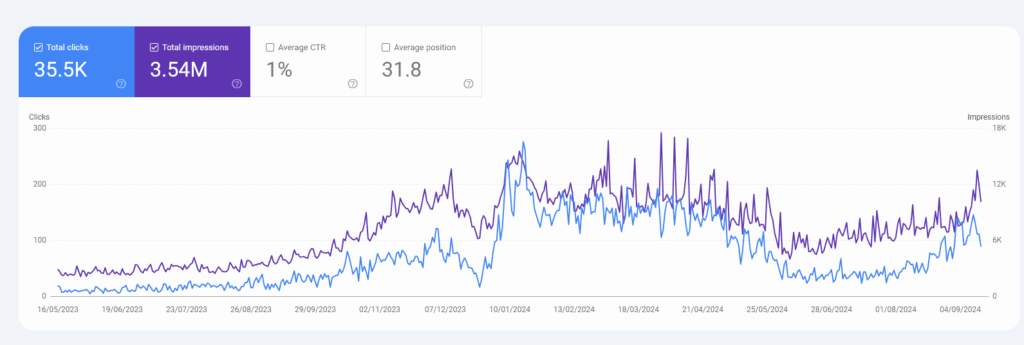How AI-Generated Content Can Backfire

The Scenario: A Surge in Content but Not in Sales
Let’s take a look at the graph to the right (Google Search Console data). It tells the story of one of our clients. In the initial period (as highlighted), we see a sharp increase in clicks and impressions. This occurred when our client’s previous marketing agency was still involved.
Why the rise? The agency had invested heavily in publishing hundreds of AI-generated articles over a short period. On the surface, this looked like a success. More articles meant more visibility, right?
However, the spike in visibility didn’t lead to a similar increase in sales. As shown in the second graph (sales data), revenue remained relatively flat. So while impressions and clicks were going up, actual business performance stayed the same.



The Problem: Quantity Over Quality
So, what went wrong? The issue came down to the quality of the content being produced. AI can generate large volumes of content quickly, but it doesn’t always guarantee accuracy or relevance. Nor does it ensure the content is aimed at the right audience.
Many of the topics were completely off-target. Some articles were even optimised for brands and products the company didn’t offer.
On top of that, the sheer volume of content made it nearly impossible to review everything properly. As a result, much of the content created by the previous agency was off-topic and poorly optimised. It often missed the mark in terms of keyword targeting and lacked the depth that Google rewards.
This meant that while more users were landing on the site, the content wasn’t engaging them. And more importantly, it wasn’t converting them into paying customers.
The Cleanup: Focusing on Targeted, High-Quality Content

The Result: A Steady Rise in Sales
Now, take a closer look at the second graph. While the traffic to the website dropped initially, revenue remained stable throughout this period. Then, a few months after the cleanup, we see a notable rise in sales. This can be attributed to the fact that the new content was better targeted, more engaging, and ultimately more useful to the client’s visitors. Rather than attracting anyone and everyone, the new content brought in the right audience,those who were actually interested in the client’s products and more likely to convert into paying customers.
The Takeaway: The Importance of Targeted, High-Quality Content
The main takeaway from this case study is simple: when it comes to content, quality matters more than quantity. AI-generated content can be a powerful tool when used correctly, but it’s crucial to ensure that what’s being produced is valuable, relevant, and targeted to the right audience. Blindly trusting that more content equals better results can lead to wasted resources, a confused audience, and stagnant sales.
If you’re considering using AI to scale up your content efforts, be sure to implement proper oversight. Always review and refine the content to ensure that it meets the needs of your audience, provides value, and aligns with your business goals.
Get in touch with us today to find out how we can help you refine your approach to content creation and start seeing the sales you deserve.
